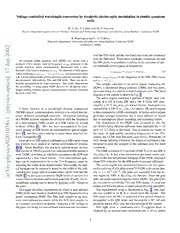Table Of ContentVoltage-controlledwavelengthconversionby terahertz electro-optic modulationindouble quantum
wells
M.Y.Su,S.Carter,andM.S.Sherwin
PhysicsDepartmentandCenterforTerahertzScienceandTechnology,UniversityofCalifornia,SantaBarbara,California93106
A.HuntingtonandL.A.Coldren
MaterialsDepartment,UniversityofCalifornia,SantaBarbara,California93106
(February2,2008)
2
0
0
2 withtheTHzfield,andtheinterbandtransitionintoresonance
withtheNIRfield. Whentheseresonanceconditionsaremet
n
An undoped double quantum well (DQW) was driven with a
a theNIRprobeismodulatedresultingintheemissionofopti-
J terahertz (THz) electric field of frequency ωTHz polarized in the calsidebandswhichappearatfrequencies
growth direction, while simultaneously illuminated with a near-
7
1 ivnefrrtaerdedsi(dNebIRan)dlassωersiadtefbraenqdue=ncωyNωINRIR+.ωTThHeiznwteanssimtyaoxfimNiIzRedupwchoenn- ωsideband =ωNIR+nωTHz (1)
] adcvoltageappliedinthegrowthdirectiontunedtheexcitonicstates whereωNIR(ωTHz)isthefrequencyoftheNIR(THz)beam
s intoresonancewithboththeTHzandNIRfields. Therewasnode- andn=±1,2,....
c
i tectableupconversion far fromresonance. Theresultsdemonstrate The sample consisted of an active region containing the
t the possibility of using gated DQW devices for all-optical wave-
p DQWs, a distributed Bragg reflector (DBR), and two gates,
length shifting between optical communication channels separated
o eachconsistingofanarrown-dopedquantum-well.Theband
s. byuptoafewTHz. diagramofthesampleisshowninFig. 1.
c The active region consisted 5 periods of DQW, each con-
i
s sisting of a 120 A˚ GaAs QW and a 100 A˚ GaAs QW sepa-
hy rated by a 25 A˚ Al0.2Ga0.8As tunnel barrier. Each period is
p A basic function in a wavelength division multiplexed separatedbya300A˚ Al0.3Ga0.7Asbarrier. Theactiveregion
[ (WDM)opticalcommunicationsnetworkistoswitchdatabe- isthincomparedtoaNIRwavelength.Athickeractiveregion
tween different wavelength channels. All-optical switching generates stronger sidebands, but is more difficult to model
1
inaWDMnetworkrequirestheabilitytoshiftthefrequency duetoreabsorption,phase-matching,andscreeningeffects.
v
of a near-infrared (NIR) carrier of a NIR carrier by several The dimensions of the DQW were designed so that the
8
3 terahertz (THz) [1]. This has been accomplished by four- two lowest-lying electron subbandswere separated by ≈ 10
0 wave mixing of NIR beams in semiconductoroptical ampli- meV (≈ 2.4 THz) at flat-band. This is aroundthe center of
1 fiers [2], and three-wavemixing in quasi-phase-matchedAl- the range of high-quality operating frequencies of our THz
0
GaAswaveguides[3]. source, the UCSB Free ElectronLaser (FEL). Within the 10
2
GenerationofTHzopticalsidebandsonaNIRcarrierbeam meVenergysplittingconstraint,thedegreeofasymmetrywas
0
/ has recently been studied in various semiconductor systems designed to peak the strength of the sideband near flat-band
s
c [4–6]. Great flexibility for practical optoelectronic devices conditions.
i thatoperateatTHzfrequenciesliewithgateddoublequantum TheDBRconsistedof15periodsof689A˚ AlAsand606A˚
s
y well(DQW)structures,inwhichtwoquantumwells(QW)are Al0.3Ga0.7As. Ithadalow-temperaturepassbandnearlycen-
h separated by a thin tunnel barrier. Their intersubband spac- teredonthelow-temperaturebandgapoftheDQW,makingit
p ingscan be engineeredto lie in the THz frequencyrangeby about95%reflectivefortheNIRprobebeamandsidebands.
:
v adjustingthewidthofthetunnelbarrier.Meanwhile,theopti- The active regionwas sandwichedbetween the two gates,
i calbandgapcanbeseparatelytunedbythewidthoftheindi- eachconsistingofaSidelta-doped70A˚ QWwithcarrierden-
X
vidualwells. Largeopticalnonlinearitiescanbebuiltintothe sity≈ 1×1012 cm−2. Thegatesareseparatedfromtheac-
r
a DQW[7]byusinganasymmetricDQWinwhichcarriersfeel tive regionby 3000A˚ Al0.3Ga0.7As barriers. Since the gate
anon-centrosymmetricconfinementpotential.Finally,thein- QWsaremuchnarrowerthantheactiveDQWs,thegateQWs
tersubbandspacingcanbetunedbyapplyingaDCvoltageto aretransparenttoboththeTHzandNIRbeams. Amesawas
thegates. etchedandNiGeAuohmiccontactsannealedtothegateQWs.
Thispaperdescribesexperimentsin whicha near-infrared The experimentalsetup is illustrated in Fig. 2. The sam-
(NIR)probelaserbeamismodulatedatTHzfrequenciesina ple was cooled to 21 K in a closed-cycle He crystat. The
gated, asymmetric DQW. The THz field couples to an exci- THzbeamfromtheFELispolarizedinthegrowthdirection,
tonic intersubband excitation while the NIR field couples to propagated in the QW plane and focused by a 90o off-axis
an excitonicinterbandexcitation. Applyinga DC voltageto parabolicmirror(F/1)ontothecleavededgeofthesample.
thegatescanbringtheintersubbandtransitionintoresonance NIR light from a continuous-wave Ti:sapphire laser is
choppedby an acousto-opticmodulatorinto ≈ 25 µs pulses
1
which overlap the ≈ 5 µs FEL pulses. The vertically-
polarized NIR beam propagates normal to the THz beam,
and was focused (F/10) at a power density of ≈ 50 W/cm2
to the same small interaction volume in the sample. The fermi level
reflected beam, sidebands, and photoluminescence (PL) are
analyzed by a second polarizer, dispersed by a 0.85 m Ra- 120Å/25Å/100Å
GaAs/Al0.2GaAs/GaAs 15x 689Å AlAs / 606Å Al0.3GaAs
man double-monochromator, and detected by a photomulti- double QW x5 distributed Bragg reflector
pliertube(PMT). front gate: back gate:
70 Å n-doped QW 70 Å n-doped QW
Atypicaln>0sidebandspectrumisshowninFig. 3. The
FIG. 1. Sample band structure, containing frontgate, active re-
conversionefficiencyscale was calibratedby attenuatingthe
gion,backgate,anddistributedBraggreflector.Nottoscale.
NIRlasertomatchthepeaksidebandsignal,andfactoringthe
lossthroughthecollectionanddispersionoptics. Wepresent
resultsforthen = +1sidebandsasacontinuousfunctionof
gatebias(V )andNIRlaserfrequency(ω )atvariousTHz [1] B.Mukherjee.OpticalCommunicationNetworks.McGraw-Hill,
g NIR
laserfrequencies(ω ). N.Y.,1997.
THz
A sideband voltage scan with ω = 1546 meV and [2] J.Zhou,N.Park,J.W.Dawson,K.J.Valhala,M.A.Newkirk,
NIR
ω = 2.5 THz is shown in Fig. 4. In this scan, V is B.I.Miller.IEEEPhot.Tech.Lett.,6(1):50,1994.
THz g
[3] S.J.B.Yoo, G.K.Chang,X.Wei,M.A.Koza,C.Caneau, R.
scanned while all other parameters are kept constant so that
Bhat.OFCProc.,4:36,1999.
ω = ω +ω . Note that at dc electric fields far
detect NIR THz [4] J.Cerne,J.Kono,T.Inoshita,M.Sherwin,M.Sundaram,A.C.
fromresonancethere are no detectablesidebands. Thistype
Gossard.App.Phys.Lett.,70(26):3543,1997.
of scan demonstrates the voltage tunability of the THz-NIR [5] J.Kono,M.Y.Su,T.Inoshita,T.Noda,M.S.Sherwin,S.J.Allen,
modulation. H.Sakaki.Phys.Rev.Lett,79(9):1758,1997.
The distinct peaks are labelled with excitonic transition [6] C.Phillips,M.Y.Su,M.S.Sherwin,J.Ko,L.Coldren.App.Phys.
assignments derived from a nonlinear susceptibility calcu- Lett.,75(9):2728,1999.
lation for THz-NIR mixing due to excitons [8,9]. The la- [7] F.Capasso.IEEEJ.QuantumElectron.,30(5):1313,1999.
belE HH X refersto theexcitonconsistingofanelectron [8] M.Y.Su,C.Phillips,J.Ko,L.Coldren,M.S.Sherwin.Physica
µ ν
B,272:438,1999.
in subband µ and a heavy hole in subband ν. A double-
[9] M. Y. Su. Unpublished. Detailed calculations to be published
resonanceconditionholdswhentheNIRfieldisresonantwith
elsewhere.
anexcitonandtheTHzfieldresonantlycouplestwoexcitons.
To understand the full resonant structure of the sideband
generationprocessat each THz frequency,the sidebandwas
measuredasacontinuousfunctionofbothω andV . By
NIR g
takingasidebandvoltagescanateachω wemeasuredthe
NIR
sideband maps shown in Figs. 5 and 6 at ω =2.0 THz
THz
and 2.5 THz (8.2 meV and 10.4 meV). Again, peaks in the
sidebandemissionoccurwhentheNIRfieldisresonantwith
anexcitonandtheTHzfieldresonantlycouplestwoexcitons;
theyarelabelledwithexcitonictransitionassignments.
Insummary,wehavemodulatedaNIRlaserbeamatTHz
frequenciesbydrivingtheexcitonicintersubbandtransitionof
anasymmetricDQW.Apairofn-dopedQWgateswhichare
transparenttoboththeNIRandTHzfieldsallowtheresonant
responseofthedevicetobetunedbyapplyingadcvoltage,al-
lowingthedevicetoactasavoltage-controllablewavelength
converter.ThepeakconversionresponseoccurswhentheNIR
fieldisresonantwithanexcitonandtheTHzfieldresonantly
couplestwoexcitons.
WegratefullythankChristophKadowandArtGossardfor
theirinput.Thisresearchwasfundedbynsf-dmr0070083.
2
to scope
pyroelectric
0.8
wire-grid
polarizers 0.7 EmHnX E1HH2X-E1HH3X
w
THz
0.6 Ea HbX
Free-electron laser
-4n (x10)0.5 w NIR w NIR+w NIR
o
PC smpeetcetrro- photodiode onversi0.4 0
PID and c0.3 E2HH1X-E1HH3X
b
cw tunable de
Ti:Sapphire AOM si0.2
variable polarizer
ND filter
0.1
0
monochromator -25 -20 -15 -10 -5 0 5 10 15
PMT
DC electric field (kV/cm)
analyzer FIG. 4. Sideband voltage scan at ωNIR = 1546 meV and
s2a1m Kple ωTHz = 2.0 THz (8.2 meV). Peak assignments are derived from
oscilliscope lens aexcitonicnonlinearsusceptibilitytheory.
1 ms voltage source
from pyroelectric
FIG.2. Experimentallayout. TheNIRbeampropagatesnormal
totheTHzbeam.ThewigglesinthePMToscilloscopetraceispho-
tonshotnoise.
200
180 x104 laser line
160
140
W)120
n
n (
missio100 n=+1
R e 80
NI
60
40
n=+2
20
FIG. 5. Sideband excitation voltage scan at ωTHz = 2.0 THz
0 (8.2meV).
1540 1545 1550 1555 1560
NIR energy (meV)
FIG. 3. n > 0 sideband spectrum at 0 V gate bias,
¯hωNIR =1542meV,¯hωTHz =8.2meV (2.0THz).
3
FIG. 6. Sideband excitation voltage scan at ωTHz = 2.5 THz
(10.4meV).
4

